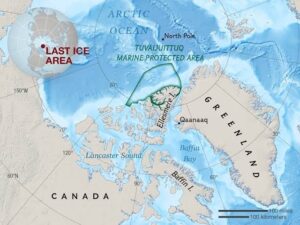In news- According to scientists, a part of the Arctic’s ice called “Last Ice Area”, has melted before expected.
Key updates-
- World Wildlife Fund (WWF)-Canada was the first to call this area the ‘Last Ice Area’.
- This region is located north of Ellesmere Island in the Canadian territory of Nunavut and Greenland.
- The area is important because it was thought to be able to help ice-dependent species as ice in the surrounding areas melted away.
- The area is used by polar bears to hunt for seals who use ice to build dens for their offspring and Walruses use the surface of the ice for foraging.
- In 2019, the Government of Canada in cooperation with Inuit leadership announced the creation of a new Marine Conservation Area that will cover 319,000 square kilometers of this habitat.
- According to National Geographic, while climate projections forecast the total disappearance of summer ice in the Arctic by the year 2040, the only place that would be able to withstand a warming climate would be the “Last Ice Area”.

- It is called so because floating sea ice there is usually so thick that it’s likely to withstand global warming for decades.
- In a paper published in the journal “Communications Earth & Environment”, researchers have noted that in August 2020 the area where the Last Ice Area (LIA) is located, experienced a record low concentration of sea ice.
- The main cause for the sudden ice loss was extraordinary strong winds that pushed the ice out the region and down the coast of Greenland.
- About 80 percent of thinning can be attributed to weather-related factors such as winds that break up and move the ice around.
- The remaining 20 percent can be attributed to longer-term thinning of the ice due to global warming.
Source: Indian Express














